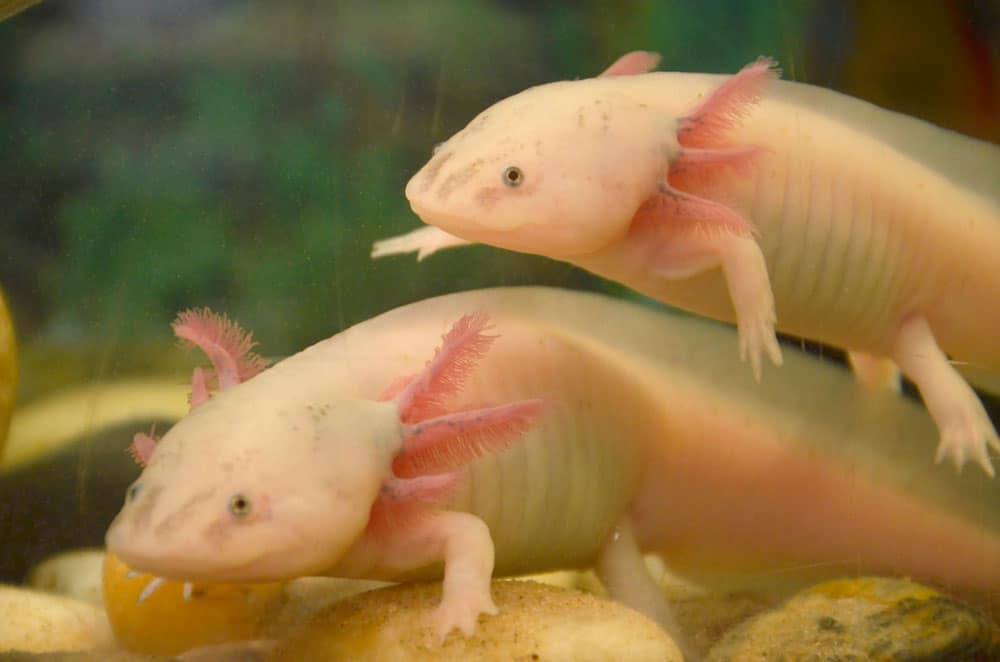Axolotls, with their unique appearance and interesting behaviors, have become increasingly popular as pets. These aquatic creatures are known for their feathery gills and ability to regenerate body parts. However, if you are considering adding an axolotl to your tank, you may be wondering what other creatures can coexist peacefully with them.
While axolotls are generally solitary animals that prefer to be kept alone, there are a few tank mates that can potentially live harmoniously with them. It’s important to note that not all fish or aquatic creatures are suitable companions for axolotls. Some may be too aggressive, while others may have different temperature or water quality requirements. Therefore, it’s crucial to choose tank mates that have similar needs and temperaments to ensure the well-being of all the inhabitants.
One of the best tank mates for axolotls is another axolotl! Axolotls are social creatures and can often be housed together without any issues. However, it’s essential to consider the size and compatibility of the axolotls before introducing them to each other. It’s recommended to keep axolotls of similar sizes together to prevent any potential bullying or aggression.
Another suitable tank mate for axolotls is the White Cloud Mountain Minnow. These small, peaceful fish are known for their hardiness and adaptability, making them an excellent choice for axolotl tanks. White Cloud Mountain Minnows prefer cooler water temperatures, similar to what axolotls require, and they also thrive in similar water conditions.
Guppy fish can also coexist peacefully with axolotls. These colorful and active fish are relatively small and won’t pose a threat to the axolotls. However, it’s important to note that guppies are prolific breeders, so you may need to monitor their population to prevent overcrowding in the tank.
Zebra Danios are another suitable option for axolotl tank mates. These small, fast-swimming fish are known for their peaceful nature and can add some activity to the tank. They are also quite hardy and can tolerate a wide range of water conditions.
If you’re looking to add some variety to your tank, you can consider adding Apple Snails. These slow-moving creatures are excellent algae eaters and can help keep the tank clean. They are generally not aggressive and can coexist peacefully with axolotls.
Small shrimp, such as Ghost Shrimp or Cherry Shrimp, can also be compatible with axolotls. However, it’s important to note that axolotls may see shrimp as food, so there is a risk of them being eaten. Therefore, it’s crucial to provide plenty of hiding spots and ensure that the shrimp are large enough to not be seen as prey.
Cardinal Tetras can also be suitable tank mates for axolotls. These small, peaceful fish are known for their vibrant colors and can add a beautiful contrast to the tank. They prefer slightly acidic water conditions, so it’s important to ensure that the water parameters are suitable for both the axolotls and the tetras.
Endler’s Livebearers are another option for axolotl tank mates. These small, colorful fish are known for their peaceful nature and adaptability. They are also livebearers, which means that they give birth to live young rather than laying eggs. This can add an interesting dynamic to the tank.
While axolotls are generally solitary creatures, there are a few tank mates that can potentially coexist peacefully with them. It’s important to choose tank mates that have similar needs and temperaments to ensure a harmonious environment for all the inhabitants. Remember to monitor the interactions between the axolotls and their tank mates and make adjustments if any signs of aggression or stress occur. With proper research and careful selection, you can create a beautiful and balanced tank that is suitable for your axolotl and its companions.

What Fish Can You Put With an Axolotl?
When it comes to choosing tank mates for axolotls, it’s important to consider their unique needs and requirements. Axolotls are amphibians and have specific conditions that need to be met in order to thrive. While they generally prefer to live alone, there are a few fish that can be compatible with axolotls in the same tank. Here are some options:
1. Other Axolotls: Axolotls can be housed together as long as they are similar in size and have enough space to swim and hide.
2. White Cloud Mountain Minnows: These small and peaceful fish can coexist with axolotls as they prefer cooler water temperatures.
3. Guppy Fish: Guppies are hardy and can tolerate the same water conditions as axolotls. However, make sure to monitor the guppies closely as axolotls may see them as potential food.
4. Zebra Danios: These active and fast-swimming fish can do well with axolotls. They are also tolerant of cooler water temperatures.
5. Apple Snails: These snails can be a good addition to an axolotl tank. They help keep the tank clean by eating algae and leftover food.
6. Small Shrimp: Some species of shrimp, like cherry shrimp or amano shrimp, can coexist with axolotls. However, make sure the shrimp are large enough to not be seen as prey.
7. Cardinal Tetra: These small and peaceful tetras can be suitable tank mates for axolotls, but it’s important to ensure that the tetras are not nipping at the axolotl’s gills.
8. Endler’s Livebearers: These small and colorful fish can be compatible with axolotls. They prefer similar water conditions and can coexist peacefully.
9. Bristlenose Plecos: These bottom-dwelling fish can be added to an axolotl tank, but ensure that the tank is large enough to accommodate their size.
10. Corydoras Catfish: These small and peaceful catfish can be suitable tank mates for axolotls. They are bottom-dwellers and won’t compete for the same space.
11. Hillstream Loach: These unique-looking fish thrive in fast-flowing water, which can also benefit axolotls by improving water circulation.
12. Glass Catfish: These transparent fish can coexist with axolotls as long as they are provided with hiding places and enough swimming space.
13. Weather Loach: These hardy and peaceful fish can tolerate the same water conditions as axolotls. They are also known for their interesting behavior.
14. Molly Fish: Some varieties of mollies can do well with axolotls. However, avoid adding aggressive or fin-nipping species.
15. Dwarf Rasbora: These small and peaceful fish can be compatible with axolotls. They prefer similar water conditions and can coexist peacefully.
Remember, it’s crucial to provide enough space and hiding spots for all tank mates to reduce stress and aggression. Regular monitoring of water parameters and compatibility is important to ensure the well-being of both axolotls and their tank mates.
Can Anything Live With An Axolotl?
There are some aquatic critters that can live with an axolotl, although it is important to choose tank mates carefully. Axolotls are generally best kept in isolation, as they thrive in a solitary environment. However, if you do decide to add other creatures to the tank, it is important to select peaceful fish that are compatible with the axolotl’s needs.
Here are some potential tank mates that can coexist with axolotls:
1. Small, peaceful fish: Look for fish species that are not known to nip at the axolotl’s delicate skin or fins. Good choices include small tetras (such as neon tetras or ember tetras), guppies, or mollies.
2. Bottom-dwelling fish: Some bottom-dwelling fish can also cohabitate with axolotls. Examples include corydoras catfish or small loaches. These fish occupy the lower levels of the tank and are less likely to interact with the axolotl.
3. Snails: Snails can be beneficial tank mates for axolotls as they help clean up any leftover food or debris. Nerite snails and mystery snails are popular choices.
4. Shrimp: Some species of shrimp, such as ghost shrimp or cherry shrimp, can coexist with axolotls. However, be aware that axolotls may view smaller shrimp as potential prey, so it’s important to provide plenty of hiding spots for the shrimp.
When introducing tank mates to an axolotl’s habitat, it is essential to monitor their interactions closely. If any signs of aggression or stress are observed, it is advisable to separate the animals immediately to prevent injury.
Remember, axolotls are primarily solitary creatures and may not enjoy the presence of tank mates. Always prioritize the axolotl’s well-being and consider providing them with a comfortable and stress-free environment.
Can You Mix Axolotl With Fish?
Axolotls and fish should not be mixed together in the same tank or aquarium. There are several reasons for this:
1. Different Habitat Requirements: Axolotls are amphibians that require specific water conditions, such as cooler temperatures and low levels of ammonia and nitrites, while fish have different temperature and water quality needs. Mixing them together can lead to stress and health issues for both species.
2. Size and Behavior Differences: Axolotls have a tendency to bite and swallow anything that can fit into their mouths, including smaller fish. This can result in injury or even death for the fish. Additionally, some fish may nip at the axolotl’s gills, which are sensitive and can cause harm.
3. Feeding Differences: Axolotls primarily eat live or frozen foods, such as bloodworms or brine shrimp, while fish have different dietary requirements. It can be challenging to ensure that all the animals in the tank are receiving appropriate nutrition.
4. Competition for Resources: Axolotls and fish may compete for food, hiding spots, and territory within the tank. This can lead to aggression and stress for both species.
5. Disease Transmission: Fish and axolotls can carry different diseases and parasites that may not affect one species but can harm the other. Mixing them increases the risk of disease transmission.
To ensure the well-being of both your axolotl and fish, it is best to keep them in separate tanks or aquariums. This will allow you to provide the specific conditions and care that each species requires, minimizing the risk of harm or stress.
How Big Do Axolotls Get?
Axolotls can grow up to 18 inches in length, although it is more common for them to reach about 9 inches. These unique creatures have a distinctive appearance, with dark-colored bodies that are often mottled with shades of green. Some axolotls may even have silvery highlights on their skin.
In terms of their physical features, axolotls have a broad and flat body, which is accompanied by a large head. One of the most characteristic aspects of an axolotl’s appearance is its feathery gills, which gently wave in the water. These gills play a crucial role in the axolotl’s ability to breathe and extract oxygen from the water.
To summarize, axolotls can grow to be quite large, reaching up to 18 inches in length, although they typically reach a size of about 9 inches. They have a unique appearance, with dark-colored bodies, greenish mottling, and sometimes silvery highlights. Their broad, flat bodies and large heads are accompanied by feathery gills, which are a defining characteristic of this fascinating species.
Conclusion
When it comes to choosing tank mates for axolotls, it is important to consider their unique needs and characteristics. While axolotls are generally peaceful creatures, they are also known to be opportunistic feeders and may potentially view smaller tank mates as food. Therefore, it is recommended to keep axolotls in isolation to ensure their safety and wellbeing.
However, if you still wish to keep other aquatic creatures with axolotls, there are a few options that may work. Other axolotls can be compatible tank mates, as long as they are around the same size and provided with plenty of hiding spaces. White Cloud Mountain Minnows, guppy fish, zebra danios, and cardinal tetras are also potential tank mates, as they are small, peaceful, and fast-moving, reducing the risk of becoming prey.
Apple snails and small shrimp can also coexist with axolotls, as long as they are not small enough to be eaten. Endler’s livebearers are another option, as they are small and colorful, providing visual interest in the tank.
It is important to note that each individual axolotl may have different temperaments and preferences, so it is crucial to monitor their behavior when introducing tank mates. If any signs of aggression or stress are observed, it is best to separate the axolotl from its tank mates to ensure their safety.
Ultimately, the best option for axolotls is to provide them with a spacious and well-maintained tank that meets their specific needs. By creating a suitable environment and focusing on their individual requirements, axolotls can thrive and live a happy and healthy life.












